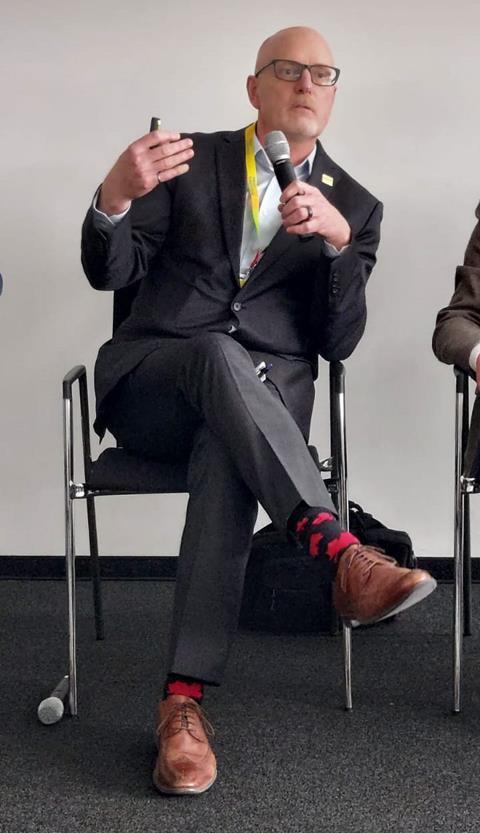Industry leaders question the scientific justification for new European proposals on packaging and packaging waste
Representatives from across Europe’s fresh produce industry say the European Commission’s proposed Packaging and Packaging Waste Regulation (PPWR) risks increasing food waste and limiting consumer access to healthy food.
PPWR is closer to being made law, after the European Parliament and European Council of EU member states embarked on discussions in Brussels to find a compromise between their own different versions of the proposed new rules.
For many of Europe’s fresh food packaging suppliers, the proposed regulation as it stands is a major cause for concern, because it promises to outlaw all plastic packaging for products that weight under 1.5kg.
Pro Food, an association which represents Europe’s major fresh food packaging suppliers, organised a round table at Fruit Logistica 2024 in Berlin to discuss PPWR’s impact. Its members argue that the regulation must focus more on packaging recycling and less on the arbitrary removal of packaging materials.
Massimiliano del Core, president of Italian industry association Ortofrutta Italia, was extremely critical of the proposal and stressed the importance of plastic packaging in defending the value of products and prolonging shelf-life.
“Furthermore,” he added, “packaging is a tool to combat food waste, which occurs 70 per cent after purchase by end consumers. No less important, finally, is the role that packaging plays in enhancing the value of fruit and vegetables in markets through the communication of product characteristics and origin. The regulation should focus on end-of-life management to incentivise recycling.”

‘Poorly conceived’
Luigi Scordamaglia, CEO of Filiera Italia and president of Eat Europe, said the proposed regulation would lead to the destruction of 32,000 jobs in Italy alone. “On the one hand, the EU invests funds in promoting the consumption of healthy foods, and primarily fruit and vegetables,” he said. “But on the other hand, by eliminating packaging, it prevents the very promotion of these products while also increasing food waste.”
Luc Vanoirbeek, chairman of Copa-Cogeca’s fruit and vegetable working group, said he was also opposed to the EC’s “ideological attitude” and insisted that new laws be “fair, realistic and affordable”. PPWR, he added, does not meet any of these requirements.
Martin Engelmann, general manager of German plastic processing association Industrievereinigung Kunststoffverpackungen, suggested a ban that affects only plastic packaging probably violates the principle of equal treatment enshrined in EU law, unless there wa an objective justification for differential treatment.
“In this regard,” he noted, “the EU legislator has a margin of discretion, but with certain limits. In particular, it must take into account all available scientific facts and data. Data and factors that in the case of PPWR have not been properly analysed through a serious and thorough impact assessment.”
Philippe Binard, general delegate of the European fresh produce association Freshfel Europe, agreed that the PPWR proposal had been poorly conceived and would affect the produce business disproportionately.
“In fact, packaging for fresh produce accounts for only 1.5 per cent of all food packaging currently used in the EU,” he commented. “Moreover, about 50 per cent of fruits and vegetables are already sold in bulk, showing that the market has already optimised as much as it can.”
He continued: “The proposal to avoid single-use plastic packaging for fresh fruits and vegetables denotes policy inconsistency, generating increased food waste and limiting the use of post-harvest treatments for better preservation of produce, which has to be done within specific packaging.”

Global challenge
Risks to the sustainability of fruit and vegetable supply chains from apparently ill-conceived regulatory proposals do not appear unique to the EU. Daniel Duguay, sustainability specialist at the Canadian Produce Marketing Association (CPMA), told the meeting in Berlin how the fresh produce business in his own country faces a very similar similar challenge.
Canada’s policymakers have targeted the sale of 75 per cent of all fruit and vegetables to be either in bulk or plastic-free packaging by 2026, rising to 95 per cent by 2028. But studies conducted by the CPMA reportedly show this would have a negative impact on the sustainability of the country’s fresh produce supply chains.
“More space should be given to closing structural gaps for the realisation of a true circular economy,” Duguay suggests. “Attention should be given to educating consumers about the role that primary packaging plays in food: the value of packaging is largely unperceived when you consider that 90 per cent of its function is performed before the consumer sees it on the store shelf.”
Mauro Salini, president of Pro Food, observed that while many in the fruit and vegetable business itself understand packaging’s importance to supply chains, this was not always obvious to the consumer. “The elimination or replacement of plastic packaging must be evaluated with scientific data not only of the packaging itself but also of the impact on logistics and content,” he concluded. “Then, when we talk about the sustainability of packaging, the approach should be holistic and consider not only the environmental aspect but also the economic and social.”
Ultimately, he said, a balance had to be struck between functionality, sustainability and circularity. “In this regard,” he continued, “in light of the positions expressed during this round table, a common stance by all supply chain actors would be appropriate to prevent PPWR from generating further damage to a vital sector.”




